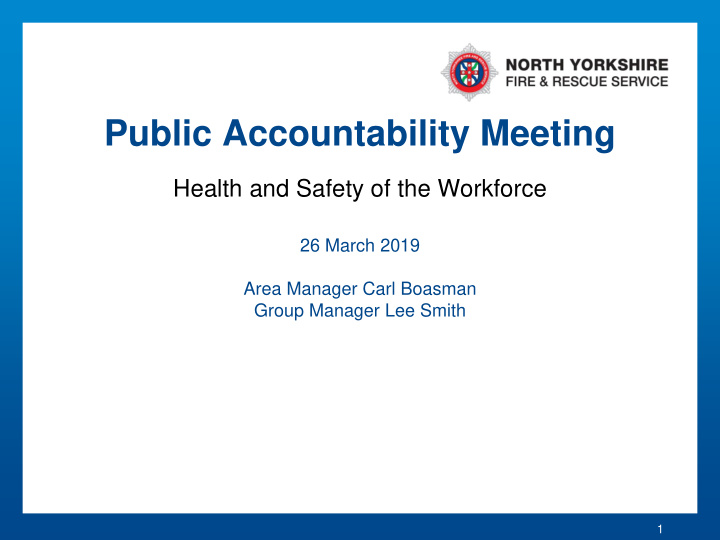



Public Accountability Meeting Health and Safety of the Workforce 26 March 2019 Area Manager Carl Boasman Group Manager Lee Smith 1
How NYFRS Complies with Health & Safety at Work Act 1974 • Provision of Health and Safety Policy • Policy sets out duties of employers and employees • Clearly assigned roles and key tasks for policy makers, planners and implementers • Promotes co-operation between employer and employees • Makes provision for consultation with representative bodies • Has agreed objectives and terms of reference with a comprehensive description of general safety rules • Describes procedure for reporting and investigating all accidents • Promotes a positive reporting and H&S culture • Previously accredited by ROSPA Gold Award in Emergency Services Sector 2
Resources • Section Manager – Group Manager Operational Assurance • H&S Manager – dedicated role • H&S Practitioner – dedicated role • Institute for Occupational safety and Health (IOSH) qualified Supervisory Managers and equivalent non uniformed staff • National Examination Board in Occupational Safety and Health (NEBOSH) qualified Middle Managers and equivalent non uniformed staff • Regional Working Groups • National Working Groups 3
Roles and Key tasks • Produce Policies and Procedures and Risk Assessments in respect of H&S matters • Provide training and H&S advice to the workforce • Ensure compliance with the legislation • Record all personal accident and injuries and vehicle accidents • Investigate serious personal/vehicle accidents • Investigate other serious safety events • Carry out workplace safety inspections • Deal with litigation cases brought against NYFRS • Review associated policies and procedures in line with agreed timescales 4
Consultation and Monitoring • Alternate Chair with representative body Health and Safety • Review documents/Standard Operating Procedures (SOPs) Sub Committee • Review accident investigations and cause for concerns (every 6-8 weeks) • Review on going issues e.g.work equipment issues • Co-ordinate with Risk Management Sub Group (RMSG) • Support and advise on arrangements of H&S policy Health and Safety • Ensure effective communication procedures are established Main Group (monthly) • Promote a positive H&S culture within the workforce. • Undertake organisational accountability and responsibility Corporate • Maintain management control Management Board (weekly) • Set strategic direction of H&S and welfare policies 5
Organisational Learning • Debriefing process embedded in Service: • Incident Debriefs. Cause for Concerns, Near Miss, Accident Investigations. Trans 26 • Structured Debrief Process and Multi agency de brief process ➢ Learning identified, actioned and embedded through HSSC and RMSG ➢ Learning used to identify training needs as part of the Training Strategy • Learning shared with other Fire and Rescue Services (FRS) and agencies (NOL and JOL) • Bulletins to staff on essential information • Tool Box Talk information on common themes 6
Organisational Learning cont’d • Schedule of workplace audits undertaken in collaboration with representative bodies • Proactive Operational Assurance audits undertaken to ensure compliance and embedding of learning outcomes • Adverse Safety events investigated in collaboration with representative bodies • Undertake specific Risk Assessments in relation to occupational health issues and training environments • Report findings to Risk Management Group, H&S Main Committee to ensure appropriate action has been taken • Report specific data to government 7
Accident Statistics Number of Incidents: 01 Jan – 31 Dec Appliances Appliances Personal ON OFF ON Blue Lights Blue Lights Duty 2013 21 28 79 2014 8 30 72 2015 12 27 72 2016 10 11 57 2017 5 13 57 2018 7 15 69 8
Staff Training • All staff, including non operational have access to e-learning modules • Broad range of topics including operational activity, H&S mandatory modules and role specific modules • LearnPro is the platform for e-learning • LearnPro provides reports for monitoring expiry dates and completion of modules • Risk Critical training provided locally and centrally at Training Centre • Operational Licence and Competence monitored by local managers overseen by Operational Assurance manager 9
Operational Competence There are nine core operational areas which are considered essential to assure operational competence: 1 Driving 2 1 2 Command and Control 3 3 Breathing Apparatus 4 Hazardous Materials 8 4 5 5 Working at Height 6 Water Rescue 6 7 Fire Service Pumps 9 8 Extrication and Rescue 9 Casualty care 7 10
Staff Wellbeing • Dedicated Health and Wellbeing Team • Dedicated rehabilitation suite and exercise physiologist • Confidential employee assistance program through external provider – PAM Assist • Early referral and intervention process through Occupational Health • Fire Fighter Charity support facilities • MIND Blue Light Pledge and Action Plan • Mental health awareness training e.g. dementia awareness training • Health awareness campaigns – “time to talk” Prostrate cancer information note 11
Staff Wellbeing • Access to fitness facilities and allocation of time for full time operational staff • Fitness Testing • Staff Survey • Mental health Champions • Lone working policy with SOS devices • Violence to staff reporting system • Health Screening – Asbestos exposure 12
Staff Survey Results Staff are positive about… 13
Ill Health Absence in NYFRS April to December 2018 Cause Of illness absence Number of occurrences 1. Muscular Skeletal 152 2. Gastro-Intestinal 129 3. Respiratory 60 4. Mental Health 27 NYFRS average days lost to sickness = 3.37 National Average = 3.71 14
Going Forward Our aims are: • Maintain low levels of ill health absence • Build on reporting structures • Continue to learn through consultation and collaboration with all stakeholders • Increase the number of mental health champions 15
Questions? 16
Recommend
More recommend